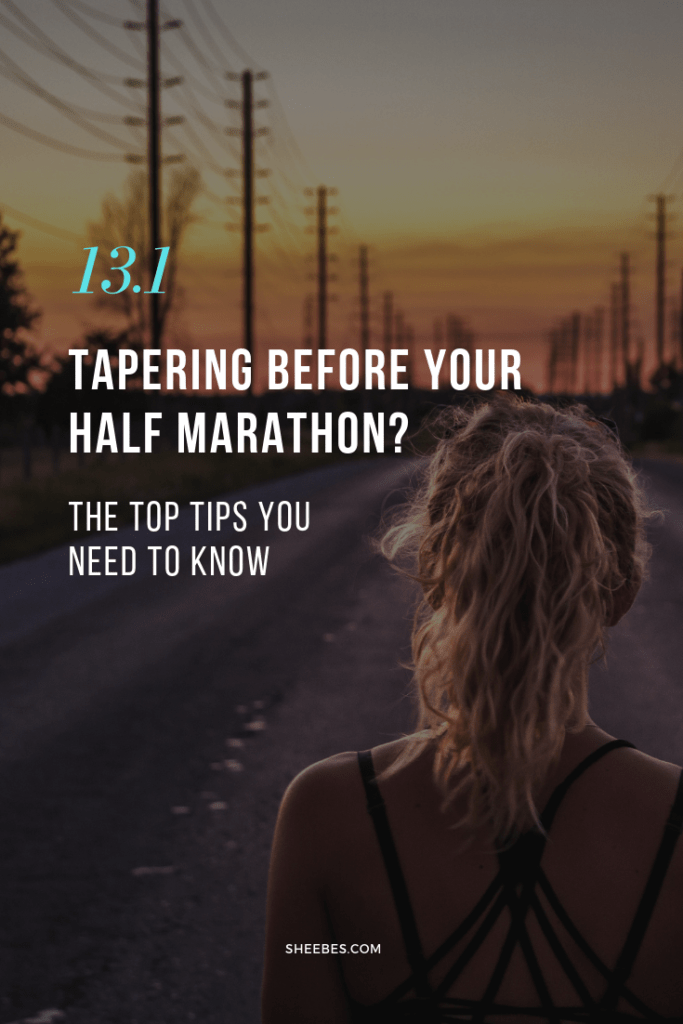Tapering before your half marathon is an essential component to your half marathon training.
After all, how hard can tapering be? You’re just running less, right?
Well…though your running volume decreases, the two weeks before your half marathon can be deceptively difficult, even for veteran half marathoners.
So if you’re running a half marathon soon, then this post is for you.
You’ll read key, specific tips on how to taper for a half marathon.
And, you’ll also find a schedule on tapering before a half marathon so you know exactly what to expect and do before your race.
Though you’ll find general physical half marathon tapering tips, we’ll also focus on mentally preparing for your race and the mistakes to avoid. Because your race day should be a fun and enjoyable experience.
Let’s get started.

Whether you’re a runner looking for running tips or a cyclist searching for cycling advice, this site is here to help you elevate your fitness game.

Affiliate Disclosure: I’m here to help you grow as a rider and runner. So to keep things running smoothly and the content free, I participate in the Amazon Services program and select affiliate networks. So, when you click on those affiliate links, I earn a small commission at no extra cost to you.
YOUR HALF MARATHON TAPER SCHEDULE
HALF MARATHON TAPER: 2 WEEKS BEFORE YOUR RACE

MAINTAIN A RUNNING ROUTINE
Tapering is crucial because you must reduce your total running mileage and volume to let your body heal from training.
But a wide range of emotions magically appear during a taper thanks to the decrease in running volume. Excitement, irritability, anxiety, you name it, it’s there.
Here’s what to do.
But first, a quick word on the following advice: this is a broad, general tip because training plans vary.
Go for a run at your normal time but reduce your daily run by about 10-20 minutes. 1
It’s tempting to sneak in some extra running time during your taper. But don’t do it! Remember, the hard work—your training—is done. You can’t cram for a half marathon during your taper.
Instead, counteract the urge to overdo it with this mantra:
I am ready.

DO A DRESS REHEARSAL
“Nothing new on race day.”
You’ve heard this advice before, right?
Nothing new on race day applies to any meals you’ll consume before your race, the fuel and gels you’re using, and to the gear you’ll wear.
Because the only thing you’ll want to focus on before and during your race is running after that personal best.
These last few weeks are the perfect time to pull those puzzle pieces together to do a dress rehearsal.
Practice eating the same food you’ll want to eat on race day. Train with the gels you’ll use. Wear the exact outfit you’ll run in for your half marathon—your shorts, shirt, socks, shoes.
Tested, reliable gear and routines infuses you with calmness on race day.

RE-FUEL YOUR MUSCLES
The taper is when your muscles rebuild and get stronger. And to seize and maintain your gains, boost your muscle recovery and performance with quality sleep.
And because you’re running less, you’ll need less food to support your training. But it doesn’t have to be complicated. The key is to eat balanced meals with a focus on nutrients. And if you want a cookie? Eat the cookie.
Need to inject some new, nutritious recipes to fuel your running? Then you’ve got to check out this list of the best cookbooks for runners.
Want even more healthy recipe ideas? Come on over and follow Sheebes on Pinterest and check out the healthy recipe boards.

REINFORCE YOUR CONFIDENCE
Did you keep a half marathon training log?
If you did, you get to review your progress. (And if not, this running planner is a fun and detailed guide that’ll help you stick with your goals.) And you’ve come a long way since the beginning.
Plus, reflecting on your training is a major confidence booster. Especially when you highlight the great runs. The runs where you thought you couldn’t do…but did. Or, the runs where you weren’t feeling motivated but ended up having an awesome time. These runs are proof you can dig deep when it’s tough and that you’re ready to race.
So go ahead, celebrate you. You’ve earned it.
If you haven’t seen this post on the mental imagery exercises to help calm your pre-race anxiety, then head over there to learn more about why and how it will help calm your nerves and improve your race performance.
THE LAST WEEK WEEK BEFORE YOUR HALF MARATHON

REDUCE THE LENGTH OF YOUR RUNS
You’ve spent the past several weeks getting ready for your half marathon so you won’t see any fitness gains in this week. The hard work’s already done. So resist the urge to go long even if you’re feeling good.
During this week, you’ll reduce your daily running time by 20-30 minutes. 2 If you’re doing a speed run, keep your intensity high but your overall workout time short.
This again depends on your training plan, but the main goal is to avoid overdoing it.

DON’T FORGET TO CORRAL THE ESSENTIALS
Do you have everything for race day?
- Cash/ credit cards
- Chapstick
- Dry clothes
- Hat
- Hair ties
- Heat blanket (this blanket is typically given to runners after a race, but it’s fantastic to use before racing to stay warm)
- Identification (this is an excellent wearable one where you can highlight any medications you’re taking or allergies you might have)
- Phone
- Rain gear
- Recovery drinks
- Safety pins
- Snacks
- Socks
- Sunglasses
- Sunscreen
- Warm up/ cool down jacket
- Watch

SET MULTIPLE RACE GOALS
If you set one goal you must reach on race day, you’re setting yourself up for massive disappointment.
Your half marathon is the culmination of many variables – your training, the weather on race day, the course, your mood, stress levels, and much more.
So when you set a single goal you must reach, say, a half marathon in 2 hours and 30 minutes but end up with a time of 2 hours and 35 minutes, you’ll feel you’ve fallen short.
But, when you target multiple race goals, you’ll foster a greater sense of satisfaction and accomplishment.
Here are a few examples.
1. Finish the race. This goal is especially important if this is your first half marathon or if you’re coming back from an injury.
2. Reach a time goal. This might be your ideal goal time where everything in training went better than planned, the weather on race day cooperated, and you were feeling strong. But, you must make sure your time goal isn’t unreasonable or you’ll get discouraged.
3. Target a race performance goal. Run a negative split race, where you’ve run the second half faster than the first half.
HALF MARATHON TAPER: THE DAY BEFORE YOUR RACE
LAY OUT PRE-RACE ESSENTIALS
Pin your race number to your shirt and remember extra safety pins, along with the packed essentials you gathered last week.
DON’T: Stress if you can’t sleep. One night won’t affect your race performance. You’ll stay wide awake before your race from your excitement, the energy of the crowds, and your adrenaline.
STAY (MOSTLY) OFF YOUR FEET
Traveling to a race? Save the lengthy strolling and sightseeing for after your race. Go for a short walk or run to wake up your legs and calm your nerves.
THE MORNING OF YOUR HALF MARATHON

EAT A TESTED BREAKFAST
If you can handle it, eat your normal breakfast a couple of hours before your race. Keep in mind that you should always eat the foods you know will work well for you. If needed, eat a small snack before your race.

DO YOUR WARMUP ROUTINE (IF YOU NORMALLY DO ONE)
You might see a fellow runner warming up with cool drills and may be tempted to follow their warmup routine. But if you don’t normally do a running warmup routine, don’t try them before your race or you’ll risk injury.

STAY WITHIN YOURSELF
Everyone starts fresh and ready to run. In the first few miles, you’ll see runners surging past you. While it’s easy to pick up the pace, remember, the start is when everyone has the most energy. You need to conserve your energy to have enough for the next 13 miles.
When you’re tapering before your half marathon, set your race strategy, aim for more than one goal, and stay on pace.
Footnotes
- Don’t Taper, Peak! McMillan Running ↩
- Don’t Taper, Peak! McMillan Running ↩